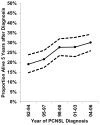Trends in primary central nervous system lymphoma incidence and survival in the U.S
- PMID: 27018254
- PMCID: PMC4961566
- DOI: 10.1111/bjh.14073
Trends in primary central nervous system lymphoma incidence and survival in the U.S
Abstract
It is suspected that primary central nervous system lymphoma (PCNSL) rates are increasing among immunocompetent people. We estimated PCNSL trends in incidence and survival among immunocompetent persons by excluding cases among human immunodeficiency virus (HIV)-infected persons and transplant recipients. PCNSL data were derived from 10 Surveillance, Epidemiology and End Results (SEER) cancer registries (1992-2011). HIV-infected cases had reported HIV infection or death due to HIV. Transplant recipient cases were estimated from the Transplant Cancer Match Study. We estimated PCNSL trends overall and among immunocompetent individuals, and survival by HIV status. A total of 4158 PCNSLs were diagnosed (36% HIV-infected; 0·9% transplant recipients). HIV prevalence in PCNSL cases declined from 64·1% (1992-1996) to 12·7% (2007-2011), while the prevalence of transplant recipients remained low. General population PCNSL rates were strongly influenced by immunosuppressed cases, particularly in 20-39 year-old men. Among immunocompetent people, PCNSL rates in men and women aged 65+ years increased significantly (1·7% and 1·6%/year), but remained stable in other age groups. Five-year survival was poor, particularly among HIV-infected cases (9·0%). Among HIV-uninfected cases, 5-year survival increased from 19·1% (1992-1994) to 30·1% (2004-2006). In summary, PCNSL rates have increased among immunocompetent elderly adults, but not in younger individuals. Survival remains poor for both HIV-infected and HIV-uninfected PCNSL patients.
Keywords: Lymphoma; central nervous system; human immunodeficiency virus; incidence; survival; transplant.
© 2016 John Wiley & Sons Ltd.
Figures



References
-
- Abrey LE. Primary central nervous system lymphoma. Curr Opin Neurol. 2009;22:675–680. - PubMed
-
- Buell JF, Gross TG, Hanaway MJ, Trofe J, Roy-Chaudhury P, First MR, Woodle ES. Posttransplant lymphoproliferative disorder: significance of central nervous system involvement. Transplant Proc. 2005;37:954–955. - PubMed
-
- Centers for Disease Control and Prevention. 1993 revised classification system for HIV infection and expanded surveillance case definition for AIDS among adolescents and adults. MMWR Recomm Rep. 1992;41:1–19. - PubMed
-
- Centers for Disease Control and Prevention. HIV Surveillance Report, 2011. Vol. 23. Centers for Disease Control and Prevention, U.S. Department of Health and Human Services; Atlanta, GA: 2013. http://www.cdc.gov/hiv/pdf/statistics_2011_hiv_surveillance_report_vol_2....
Publication types
MeSH terms
Grants and funding
- U58 DP003931/DP/NCCDPHP CDC HHS/United States
- HHSN261201000037C/CA/NCI NIH HHS/United States
- U58 DP003875/DP/NCCDPHP CDC HHS/United States
- N01 PC035139/CA/NCI NIH HHS/United States
- N01 PC035137/CA/NCI NIH HHS/United States
- HHSN261201300071C/CA/NCI NIH HHS/United States
- U58 DP003920/DP/NCCDPHP CDC HHS/United States
- N01 PC035142/CA/NCI NIH HHS/United States
- U58 DP000848/DP/NCCDPHP CDC HHS/United States
- Z99 CA999999/ImNIH/Intramural NIH HHS/United States
- U58 DP000832/DP/NCCDPHP CDC HHS/United States
- U58 DP000824/DP/NCCDPHP CDC HHS/United States
- U58 DP003883/DP/NCCDPHP CDC HHS/United States
- N01 PC035143/CA/NCI NIH HHS/United States
- HHSN261201000036C/CA/NCI NIH HHS/United States
- U58 DP003879/DP/NCCDPHP CDC HHS/United States
- HHSN261201300011C/RC/CCR NIH HHS/United States
- U58 DP000807/DP/NCCDPHP CDC HHS/United States
- HHSN261201300021C/CA/NCI NIH HHS/United States
- HHSN261201000035I/CA/NCI NIH HHS/United States
- HHSN261201000024C/CA/NCI NIH HHS/United States
- HHSN261201000035C/PC/NCI NIH HHS/United States
- HHSN261201000034C/CA/NCI NIH HHS/United States
- U58 DP003921/DP/NCCDPHP CDC HHS/United States
LinkOut - more resources
Full Text Sources
Other Literature Sources
Medical

